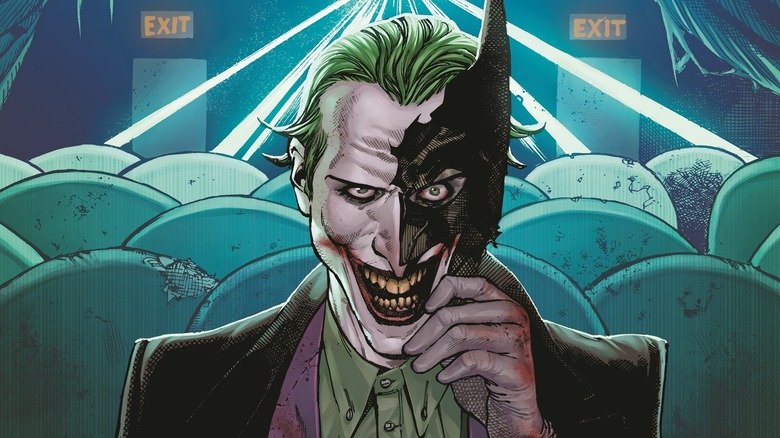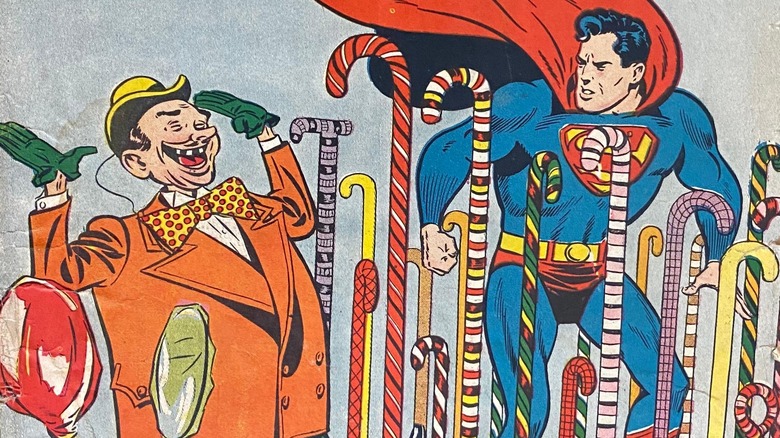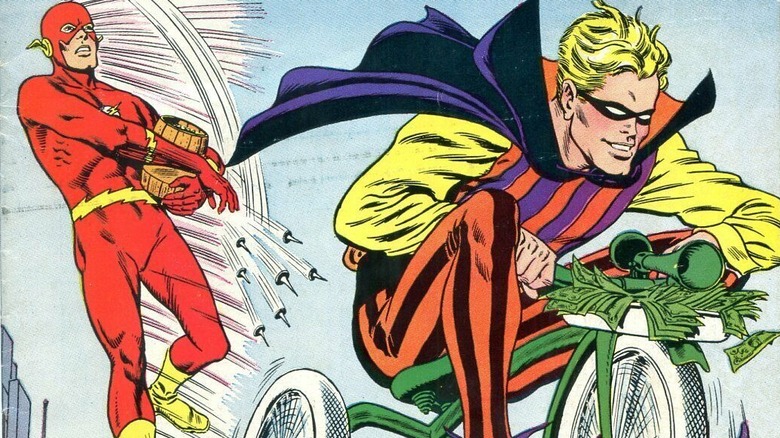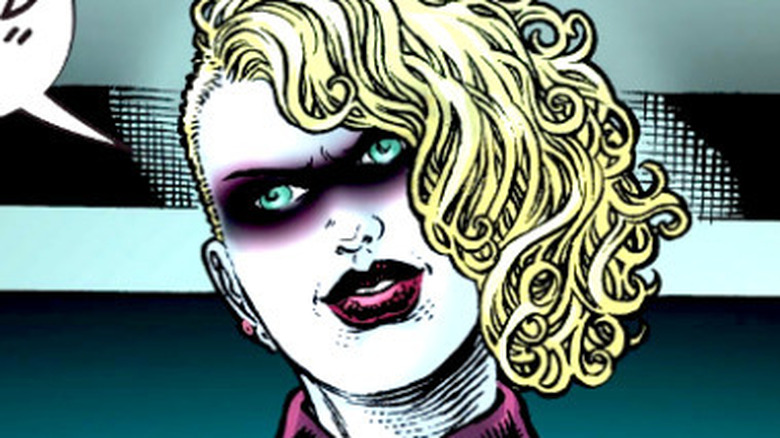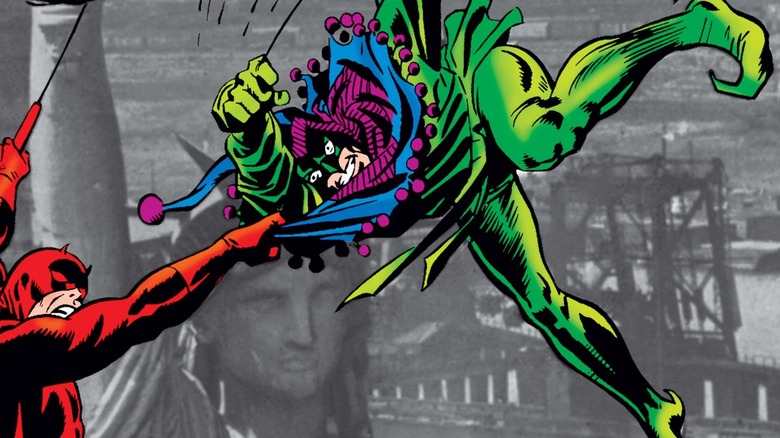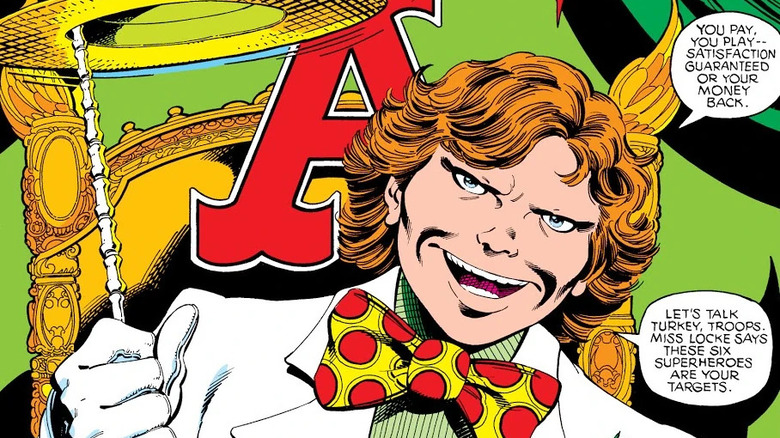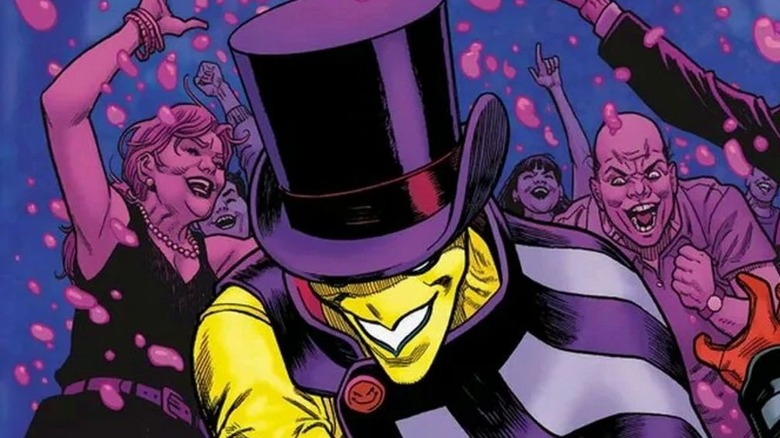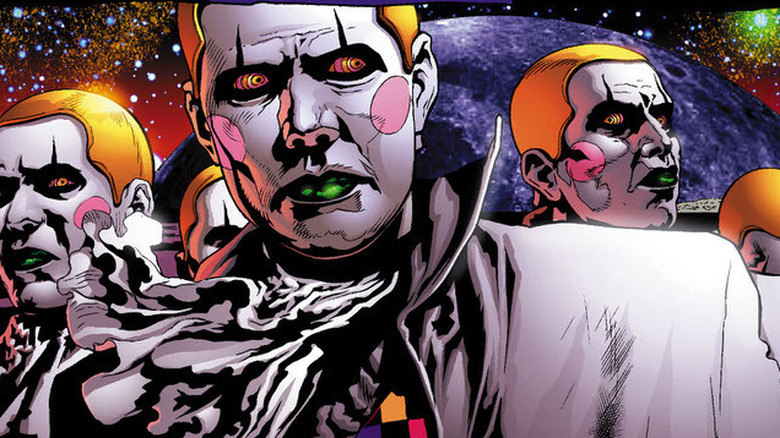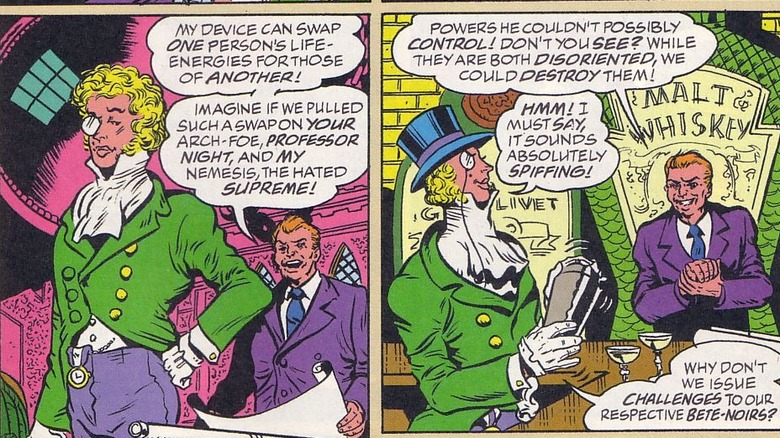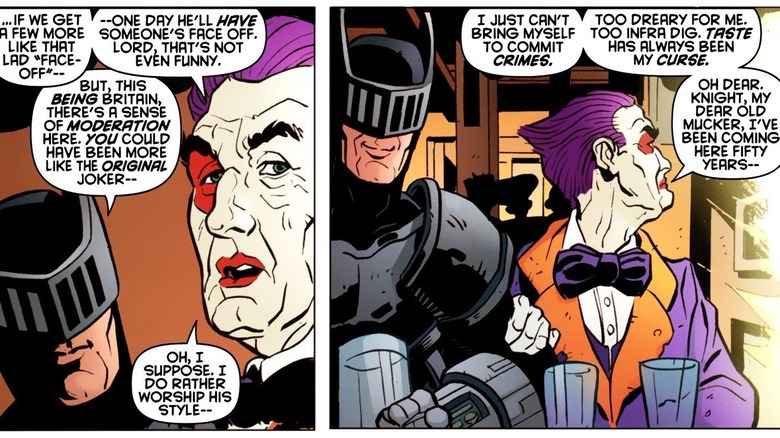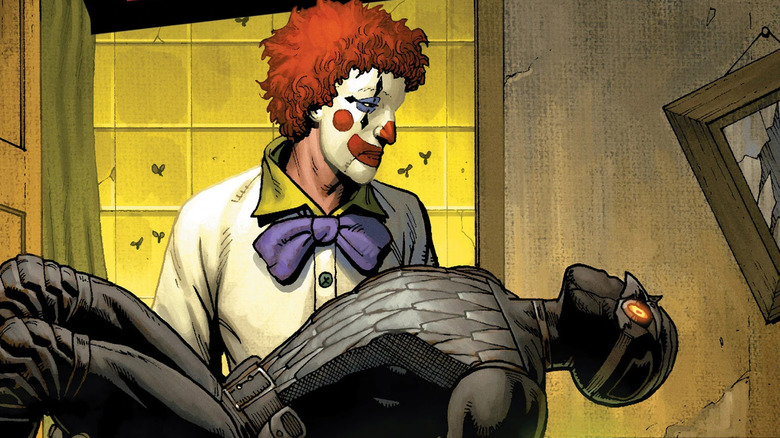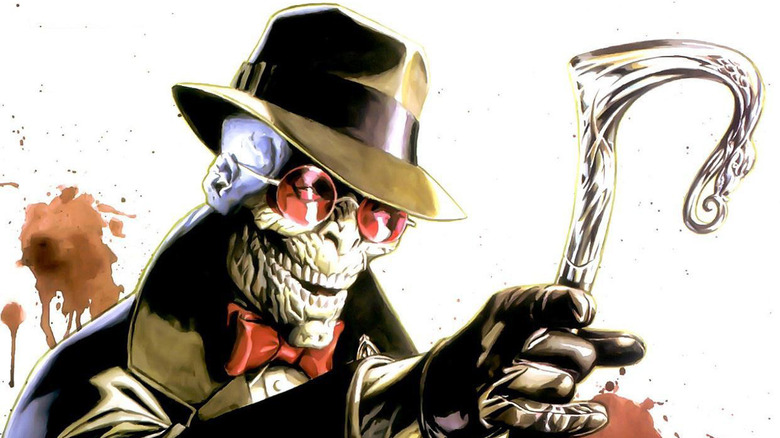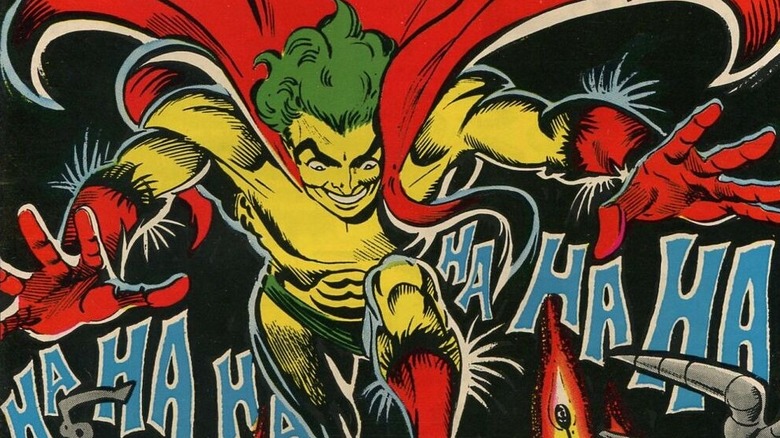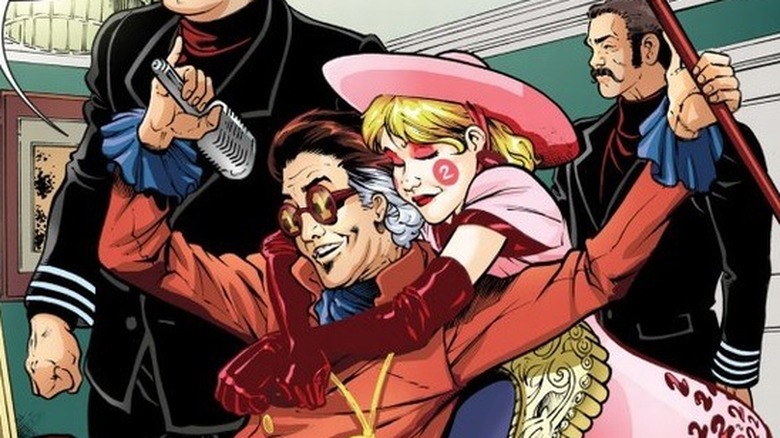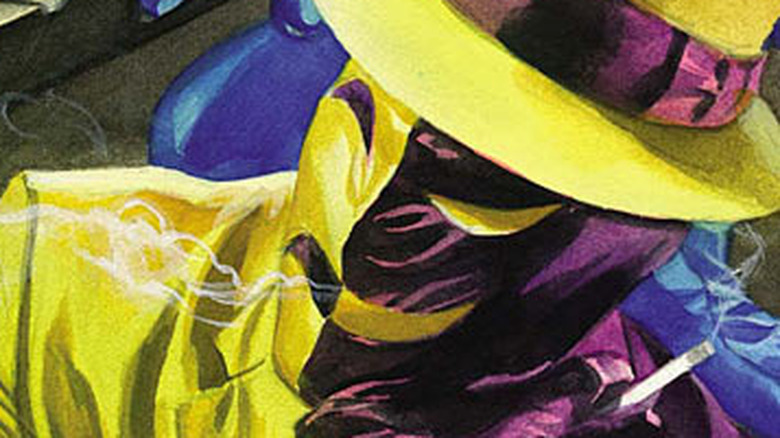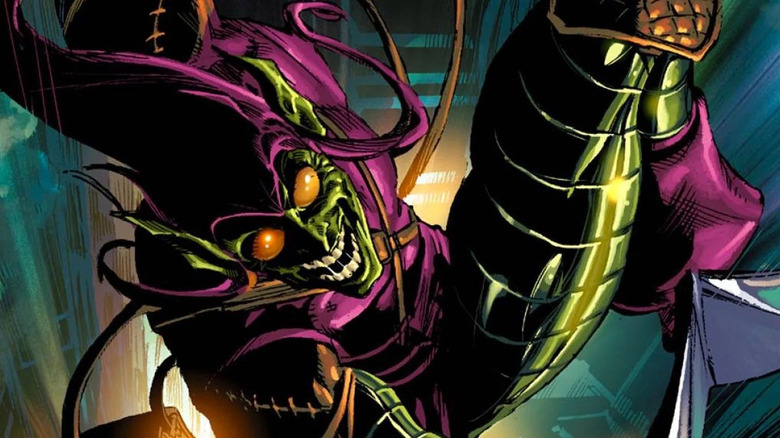15 Times Comics Tried Ripping Off The Joker Character
As various versions of Batman and the DC Universe he occupies continue to spread across all kinds of media, it's hard to think of a comic book supervillain more prominent than the Joker. Since he first appeared in 1940's "Batman" #1 by Bill Finger and Jerry Robinson, the Clown Prince of Crime has been the Dark Knight Detective's greatest nemesis, a force for violence and chaos in contrast to Batman's championing of law and order.
Traditionally, the Joker is given no real name, although you might have heard him called Jack Napier or Arthur Fleck. Whoever he once was, he's only the Joker now, ever since he fell into that vat of chemicals that bleached his skin and turned his hair green. He might look civilized in his well-tailored purple three-piece suit, but he'll murder anyone who crosses his path without a second thought. His preferred method is poison, especially a custom one that causes his victims to die with ghastly grins on their faces, but he's not averse to using guns, crowbars, or whatever else is at hand.
Over the years, many other comic book characters have taken inspiration from the Joker, some more directly than others. Given the character's success and longevity, that's probably inevitable. Some of them are acknowledged homages and others are just straight-up ripoffs, but here are fifteen comic book characters who wouldn't exist without the Joker's example.
Prankster
The first significant comics character who owed a lot to the Joker showed up very close to home, a member of Superman's rogues gallery. Debuting in 1942, the Prankster is a very similar style of villain, using practical jokes to commit crimes and fight Superman. With a round body, buck teeth, and a goofy face, the Prankster's appearance was not so much a clown as a stereotypical vaudeville or early cinema comedian, complete with a bowler hat and oversized bowtie. His early crimes had a very Joker-esque mix of the zany and the deadly. In his first story in "Action Comics" #51, for example, he and his gang go into a bank and insistently give the employees money, then give more money away on the street. Naturally, this is all a lead-up to stealing far more money, and along the way, he traps Lois Lane along with his own henchmen behind a glass wall where poison gas is being released. Of course, Superman saves the day.
Prankster has stuck around throughout Superman's long history, even meeting the Joker eventually. Around 2000, he was given a complete makeover to be younger and in better shape, giving him a more intimidating physical presence (although not to Superman, obviously). While the vaudeville comedian look was hardly relevant by that time, it still robbed the character of a bit of his distinctiveness (and as a Joker knockoff, he didn't start with all that much).
Trickster
The Trickster first appeared in 1960's "The Flash" #113, and soon became a key member of the Flash's rogues gallery. He was actually designed by Carmine Infantino for the cover of the issue, after which John Broome wrote the story to fit the cover. James Jesse was a trapeze artist in the circus, but decided to become a criminal on a lark, taking inspiration from his "reverse namesake," Jesse James. This being the Silver Age of Comics, the Trickster would often create fantastical gadgets to aid in his crimes, such as shoes that enabled him to walk on air (at which point you'd think a patent would be more lucrative than robbing a bank). It was his harlequin costume that tipped the Flash off that the Trickster worked in the circus, which led to his capture in that first story.
The Trickster appeared on the 1990 "The Flash" TV series, where he was memorably played by Mark Hamill, who soon went on to voice the Joker on "Batman: The Animated Series." This version of James Jesse was far more psychopathic and dangerous than the comics' incarnation, and it certainly gave the actor everyone knew as Luke Skywalker a chance to show how great he could be playing an over-the-top supervillain, which became a major part of his career going forward.
Alice
The modern incarnation of Batwoman, aka Kate Kane, was created not as a sidekick or supporting character for Batman, but as a sort of reflection of him that could stand as her own hero. But if Batman's archenemy is a clown, who should be Batwoman's archenemy? A female clown is on the nose, but it works. If the Joker is inextricably bound to Batman as an opposite number, why not literalize that for Batwoman by making the evil clown her long-lost twin sister? Thus came Red Alice, who was Beth Kane, the sister Kate thought had been killed by terrorists when they were children. In truth Beth was kidnapped by those terrorists and raised by a cult of crime-worshipping zealots, growing up to be a Lewis Carroll obsessed harlequin who's every bit as unhinged and dangerous as her sister is competent and heroic.
Personality-wise, Alice is quite distinct from the Joker. Her madness manifests in more of a dreamy surrealist way than the constant cackling of Batman's nemesis. Still, it can't be overlooked that Greg Rucka and J.H. Williams III, who introduced Alice in "Detective Comics" #854 decided to make Batwoman's archenemy a female clown. That doesn't just happen by accident.
Jester
Created by Stan Lee and Gene Colan for "Daredevil" #42, the Jester was a distinctly Marvel Age of Comics take on a Joker-like villain. An egotistical aspiring actor, Jonathan Powers trained in various areas that he thought would make him a more versatile star, such as gymnastics, weight training, and fencing. Unfortunately, he declined to actually take acting classes, feeling certain his raw talent would be enough (it wasn't). Frustrated that even with all his skills the best acting job he could get was as the stooge who gets pies thrown in his face on a kids' show, Powers turned his skills to crime. With a colorful costume and a bunch of comical gadgets built by the arms dealer known as the Tinkerer, the Jester made a name for himself as a thief and enforcer for hire, but soon his primary motivation became revenge on Daredevil, who had previously thwarted him. Like so many other supervillains, he let opportunities for wealth and power pass him by in favor of an agenda against a particular crime fighter.
In time Jonathan Powers retired, and another criminal named Jody Putt took on the Jester identity and fought the heroes Cloak and Dagger. In the current Marvel Comics continuity, both Jesters are dead, but the nature of superhero comics is that it's only a matter of time until one or both return.
Arcade
Another Marvel villain, Arcade first appeared in 1978's "Marvel Team-Up" #65, by Chris Claremont and John Byrne. In that book, he faced Spider-Man and Captain Britain, but Claremont and Byrne soon introduced him to the title they were best known for, "X-Men," and he's been mainly an X-villain ever since. A highly paid assassin, Arcade created elaborate game-based death traps for his targets, in an underground amusement park-like complex he fittingly named Murderworld.
Arcade isn't a clone of the Joker, but he's definitely built around some essential aspects of that character. In the Batman comics, and especially the 1960s "Batman" TV show, the Joker was known for trapping Batman and Robin in elaborate death traps, which became Arcade's entire gimmick. He also has a similarly theatrical demeanor, and visually resembles a palette-swapped Joker—wavy hair, constant grin, bowtie, and old-fashioned suit. Unlike the Joker and most other villains, who consider their death traps infallible and are shocked when the heroes escape, Arcade made that part of his gimmick from the beginning. He likes to give his targets a small chance of escape and survival, just to make the "game" a little more sporting. It does make one wonder how he remains a highly paid assassin if people keep escaping from Murderworld, but that's the sort of supervillain logic it's best not to dwell on.
Madcap
The Joker is ostensibly a normal human, but like many supervillains he's proven incredibly hard to kill. The entire building he's in might explode in a giant fireball, but the Joker will be a back a few months later to bedevil Batman once again. Some similar characters have literalized that "unkillibility," most notably the Marvel supervillain Madcap. Created by Mark Gruenwald and Paul Neary, Madcap was introduced in "Captain America" #307, but he appeared across the Marvel Universe and faced many different heroes. In recent years he's become primarily associated with Deadpool, another famously unkillable madman.
Madcap was once a deeply religious young man who believed there was an order and purpose to the universe. Then one day, his entire family was on a bus with the rest of their church's congregation, on the way to a picnic. The bus had a horrific accident with a tanker truck full of an experimental chemical. His entire family and basically everyone he knew were killed, while he was infused with the chemical and gained superpowers. When he realized what had happened, the young man lost his mind, deciding that life is utterly meaningless and donning the harlequin colors of Madcap.
In addition to instantly healing from any wound, even one that should be fatal, Madcap also has the ability to temporarily affect the minds of others who meet his gaze, lowering their inhibitions and impairing their judgment, causing them to act in an erratic and euphoric manner that often leads to potentially fatal risk-taking. This combination of powers makes him an utterly befuddling foe for any Marvel superhero.
Painted Doll
The Painted Doll, a villain created by Alan Moore and J.H. Williams III for the America's Best Comics series "Promethea," is equally hard to kill, but for a very different reason. The arch-enemy of the Five Swell Guys, the premier superheroes of their world, the Painted Doll inexplicably returns every time he's seemingly killed. This is especially troubling because the Painted Doll's entire purpose in life is to murder people for fun. The laughing acrobatic clown chooses victims because they're different from anyone he's killed before, making him almost as difficult to predict as he is to destroy.
Eventually the Painted Doll is revealed to be a series of androids, secretly created by one of the Five Swell Guys. Each time one of the androids was destroyed, another Painted Doll would awaken in a secret location, never realizing he wasn't the original. When all the androids are awakened at once, they proceed to kill each other, excited by the prospect of murdering someone exactly like them, a new level of novelty. The surviving Painted Doll reforms after realizing his true nature, and replaces his creator as one of the FIve Swell Guys.
The Painted Doll is a great example of how pastiche is used in comics, often as a kind of narrative shorthand. He wasn't the main villain of "Promethea," just as the Five Swell Guys weren't the protagonists. But most readers are obviously familiar with the Joker, so it only takes a panel or two of a dapper clown murdering people for those readers to understand the character's basic deal (at least until there's time to reveal the more complicated details later).
Jack-a-Dandy
Another Alan Moore creation, Jack-a-Dandy is a pastiche in a world of pastiches. Moore had taken Rob Liefeld's character Supreme, who was already a Superman knock-off, and made him into a much more direct pastiche with whom Moore could tell stories that would never be told with the real DC Comics character. As such, Supreme was friends with a darker hero named Professor Night, who happened to look a lot like Batman, and Professor Night's archenemy was Jack-a-Dandy. He was introduced in a story where he teamed up with Supreme's archenemy, Darius Dax, who's basically Lex Luthor with hair.
Unlike most of the characters on this list, Jack-a-Dandy isn't a clown or even particularly comical. He presents himself as an antiquated British fop, with a monocle, frilly shirt, pocket watch, and so forth. In fact, when he dons his top hat, he might be considered a combination of the Joker and the Penguin. With his skinny frame, jacket with tails, and obsession with Professor night, however, he's recognizable as a take on the Joker to anyone who remembers all those "Is the Joker gay?" conversations that used to go on before the introduction of Harley Quinn.
Jarvis Poker, the British Joker
As a deliberate in-universe copycat, Jarvis Poker might not even belong on this list, but it's hard to imagine collecting Joker knockoffs and leaving out the British Joker himself. The Knight and Squire had long existed as DC's British equivalent of Batman and Robin, but when they got their own comic in 2010, creators Paul Cornell and Jimmy Broxton introduced a whole world of British superheroes and villains who had mostly never been seen before, although the premise was that they'd always been around, DC Comics just hadn't been telling their stories.
One of those characters was Jarvis Poker, the British Joker. Poker modeled himself after the original Joker, but isn't actually a psychopath, or even a criminal by nature. He's just an eccentric man in a purple suit and clown makeup who likes causing a gentler, more English sort of chaos. It's an interesting look at the kind of person who might take inspiration from the Joker in a world where he exists, and how different from the original article that person might turn out to be.
Whiteface
Perhaps inevitably, Marvel Comics has their own Batman pastiche (no, not Moon Knight). Millionaire Kyle Richmond, alias Nighthawk, was introduced as a member of the Squadron Supreme, an ersatz Justice League from an alternate Earth. In 2003, writer J. Michael Straczynski and artist Gary Frank rebooted the team under the name "Supreme Power" as part of Marvel's MAX line of adults-only comics. The new version of Nighthawk was a wealthy black man whose parents had been killed by white supremacists, giving his crimefighting an unapologetically racial aspect. When he got his own Joker, the racial element remained.
Created by Daniel Way and Steve Dillon for the spinoff series "Supreme Power: Nighthawk," Whiteface was actually Steven Binst, a pharmacist who'd spent ten years in prison for poisoning his black customers. He escapes by murdering a visiting clown and stealing his clothes, then maintains the clown identity to facilitate his new crimes. He takes control of a drug ring on the South Side of Chicago and once again distributes a poisoned product, killing a large number of addicts. Then he kills the Mayor's family at a birthday party, and even drugs Nighthawk, trying to convince the hero that they're not so different. Naturally, Nighthawk is having none of that, and the book ends with him killing Whiteface.
As part of the "MAX" project, this story was dark and edgy to an almost comical degree, but if the racist Joker who poisoned people with deadly crack cocaine (until a meaner Batman killed him, of course) doesn't belong on this list, who does?
Mr. Rictus
Mister Rictus is the villain of "Wanted," a 2003 comic by Mark Millar and J.G. Jones. More accurately, Mister Rictus is the antagonist of the story, because all the major characters in this book are villains. "Wanted" is another comic aimed at adult readers, and it makes "Supreme Power: Nighthawk" look like "My Little Pony" by comparison. "Wanted" takes place in a world where supervillains have completely eradicated superheroes and altered reality so that regular people don't remember they ever existed. A secret society of supervillains called the Fraternity secretly rules the world, led by the Council of Five, a quintet of the worst villains humanity has ever faced.
The main character, Wesley Gibson, is already an entitled jerk when the story starts, but when he inherits his father's supervillain identity as the Killer and joins the Fraternity, he quickly becomes an enthusiastic murderer and rapist. The nastiness of this comic runs deep, and the plot is barely worth summarizing, but Mister Rictus is the nastiest character of all. After an accident left him horribly scarred and led to a near-death experience in which he saw that only darkness awaited him, not Heaven or Hell, he became an absolute nihilist, pursuing every crime imaginable. And of course, he also has a permanent grin and a tailored suit, which along with the whole "nihilism and chaos" thing, certainly qualifies him for this list. Next to Mister Rictus, however, the Joker starts to look like a pretty nice guy.
The Creeper
Steve Ditko, the idiosyncratic writer/artist who created the Creeper for DC Comics, would probably deny that he's inspired by the Joker. Still, while Ditko created a ton of original characters from Spider-Man to Doctor Strange to Squirrel Girl, it's hard to overlook the fact that the Creeper is a grinning maniac with green hair who's known for his unmistakable laugh. Originally a journalist named Jack Ryder, he was transformed by an incident involving a Halloween costume and an eccentric scientist, and chose to become a superhero, albeit a disturbing cackling superhero. Originally his laughter and erratic behavior was just an act by Ryder to unnerve criminals, but over time the Creeper evolved his own personality, separate from Jack's, that really was as unhinged as he seemed.
The Creeper's resemblance to the Joker is so unmistakable that when he was featured on an episode of "The New Batman Adventures," the two were directly connected. In this version of his origin, Jack Ryder is a TV reporter doing a story on the Joker, which involves going to Ace Chemicals, where the Joker became who he is. Displeased with Ryder's reporting, the Joker gasses Jack and dumps him into a vat of the same chemicals that transformed him. Jack Ryder undergoes a similar transformation but becomes the yellow-skinned Creeper and swears revenge against the Joker. He becomes such a thorn in the clown's side that the Joker eventually begs Batman to arrest him, to rid him of the Creeper's vexations.
Number One
"The Wrong Earth" is an indie comic by Tom Peyer and Jamal Igle that's unapologetically inspired by Batman and his world. In fact, it's inspired by two of Batman's worlds. On one Earth, Dragonflyman and his teen sidekick Stinger have bloodless fights with colorful villains in a manner reminiscent of the 1960's "Batman" TV show and the old comics that inspired it. On another Earth, the Dragonfly wages a grim war against violent criminals and psychopaths. Neither world is aware of the other, until the Dragonfly and Dragonflyman accidentally switch places and neither can figure out how to get home. So the Dragonfly has to adjust his tactics for a world where his usual level of violence is unheard of, while Dragonflyman is overwhelmed by the joyless and bloody world in which he finds himself.
Both heroes have an archenemy named Number One, an egotistical criminal mastermind with a theatrical streak. Of course, Dragonflyman's Number One is a cartoonish villain who just wants to pull off zany crimes and give his henchmen clever matching outfits. The Dragonfly's Number One, on the other hand, wants to kill people—lots of people. When the two heroes switch worlds, each has to deal with a version of the villain whose tactics are a surprise to him. Not to put too fine a point on it, but this is kind of like a comic where Christian Bale fights Cesar Romero, while Adam West has to face Heath Ledger.
Mister Drama
Kurt Busiek's "Astro City" is a playground for the writer—a noted historian of superhero comics—to explore superhero tropes and ideas free from the confines of Marvel or DC. Over the years, Busiek has told some of the richest and deepest superhero stories imaginable, without ever shying away from the sillier aspects of the genre. Not every Astro City character is a direct pastiche of a hero or villain from a more mainstream comic, but some unmistakably are. And one of those is Mister Drama, the brightly dressed archvillain who was a thorn in the side of the original Jack-in-the-Box.
Astro City's most prominent street level hero, Jack-in-the-Box himself has the appearance of a costumed clown, so naturally his Joker-esque enemy has to go in a different direction. Rather than a clown with circus trappings, Mister Drama is an actor with theatrical trappings. Frank Darman wanted to be a real actor in the theatre, but turned to crime after an audition that went particularly badly. Donning a purple and yellow suit and a half-comedy/half-tragedy mask, Mister Drama became a successful supervillain and the Jack-in-the-Box's archenemy.
Green Goblin
Who's the most important supervillain known for dressing in green and purple, sporting a disturbing grin, and cackling with laughter as he murders people? Yes, it's obviously the Joker, that's why we're here. But the second most important, only slightly beneath the Joker in fame, longevity, and screen adaptations? That's got to be the Green Goblin, Spider-Man's greatest villain. Created by Stan Lee and Steve Ditko, wealthy industrialist Norman Osborn became the Green Goblin after an experimental formula enhanced his strength and intelligence but left him dangerously insane. He embraced a life of crime while maintaining his public facade of normalcy as Osborn, and had many encounters with Spider-Man, who turned out to be his son's best friend. The Green Goblin was responsible for the most tragic moment of Spider-Man's life, the death of his girlfriend Gwen Stacy. The Goblin was seemingly killed in that same story, but of course he's returned many times since to once again menace the wall-crawler.
But is he a Joker rip-off? It's hard to say for sure. The Green Goblin has an active secret identity, which the Joker never has. Whereas the Joker likes to poison people, the Green Goblin prefers blowing them up with pumpkin-shaped grenades. There are a lot of differences, but the signature colors, the maniacal grin and the laughter are hard to overlook. Ultimately it doesn't really matter that much whether the Green Goblin takes inspiration from the Joker, nor whether any other character does. It's interesting to talk about, but it doesn't devalue a character to incorporate elements of what came before. The Joker's out there in the collective unconscious—he's existed since 1940, after all. It's only natural that creators are going to take inspiration from such a classic character.
